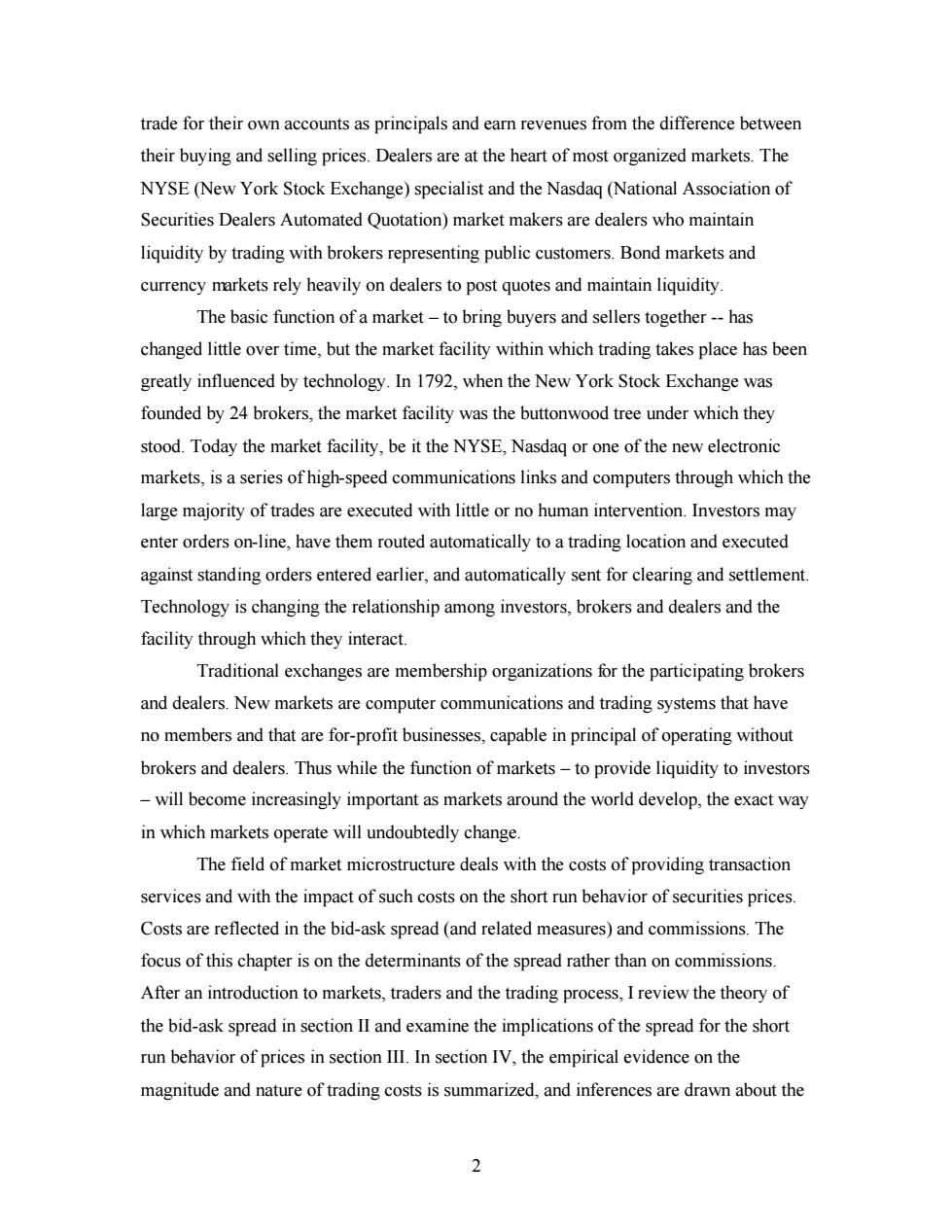正在加载图片...

trade for their own accounts as principals and earn revenues from the difference between their buying and selling prices.Dealers are at the heart of most organized markets.The NYSE(New York Stock Exchange)specialist and the Nasdaq(National Association of Securities Dealers Automated Quotation)market makers are dealers who maintain liquidity by trading with brokers representing public customers.Bond markets and currency markets rely heavily on dealers to post quotes and maintain liquidity The basic function of a market-to bring buyers and sellers together--has changed little over time,but the market facility within which trading takes place has been greatly influenced by technology.In 1792,when the New York Stock Exchange was founded by 24 brokers,the market facility was the buttonwood tree under which they stood.Today the market facility,be it the NYSE,Nasdaq or one of the new electronic markets,is a series ofhigh-speed communications links and computers through which the large majority of trades are executed with little or no human intervention.Investors may enter orders on-line,have them routed automatically to a trading location and executed against standing orders entered earlier,and automatically sent for clearing and settlement. Technology is changing the relationship among investors,brokers and dealers and the facility through which they interact. Traditional exchanges are membership organizations for the participating brokers and dealers.New markets are computer communications and trading systems that have no members and that are for-profit businesses,capable in principal of operating without brokers and dealers.Thus while the function of markets-to provide liquidity to investors -will become increasingly important as markets around the world develop,the exact way in which markets operate will undoubtedly change. The field of market microstructure deals with the costs of providing transaction services and with the impact of such costs on the short run behavior of securities prices. Costs are reflected in the bid-ask spread(and related measures)and commissions.The focus of this chapter is on the determinants of the spread rather than on commissions. After an introduction to markets,traders and the trading process,I review the theory of the bid-ask spread in section II and examine the implications of the spread for the short run behavior of prices in section III.In section IV,the empirical evidence on the magnitude and nature of trading costs is summarized,and inferences are drawn about the 22 trade for their own accounts as principals and earn revenues from the difference between their buying and selling prices. Dealers are at the heart of most organized markets. The NYSE (New York Stock Exchange) specialist and the Nasdaq (National Association of Securities Dealers Automated Quotation) market makers are dealers who maintain liquidity by trading with brokers representing public customers. Bond markets and currency markets rely heavily on dealers to post quotes and maintain liquidity. The basic function of a market – to bring buyers and sellers together -- has changed little over time, but the market facility within which trading takes place has been greatly influenced by technology. In 1792, when the New York Stock Exchange was founded by 24 brokers, the market facility was the buttonwood tree under which they stood. Today the market facility, be it the NYSE, Nasdaq or one of the new electronic markets, is a series of high-speed communications links and computers through which the large majority of trades are executed with little or no human intervention. Investors may enter orders on-line, have them routed automatically to a trading location and executed against standing orders entered earlier, and automatically sent for clearing and settlement. Technology is changing the relationship among investors, brokers and dealers and the facility through which they interact. Traditional exchanges are membership organizations for the participating brokers and dealers. New markets are computer communications and trading systems that have no members and that are for-profit businesses, capable in principal of operating without brokers and dealers. Thus while the function of markets – to provide liquidity to investors – will become increasingly important as markets around the world develop, the exact way in which markets operate will undoubtedly change. The field of market microstructure deals with the costs of providing transaction services and with the impact of such costs on the short run behavior of securities prices. Costs are reflected in the bid-ask spread (and related measures) and commissions. The focus of this chapter is on the determinants of the spread rather than on commissions. After an introduction to markets, traders and the trading process, I review the theory of the bid-ask spread in section II and examine the implications of the spread for the short run behavior of prices in section III. In section IV, the empirical evidence on the magnitude and nature of trading costs is summarized, and inferences are drawn about the